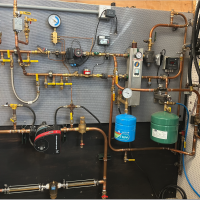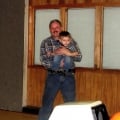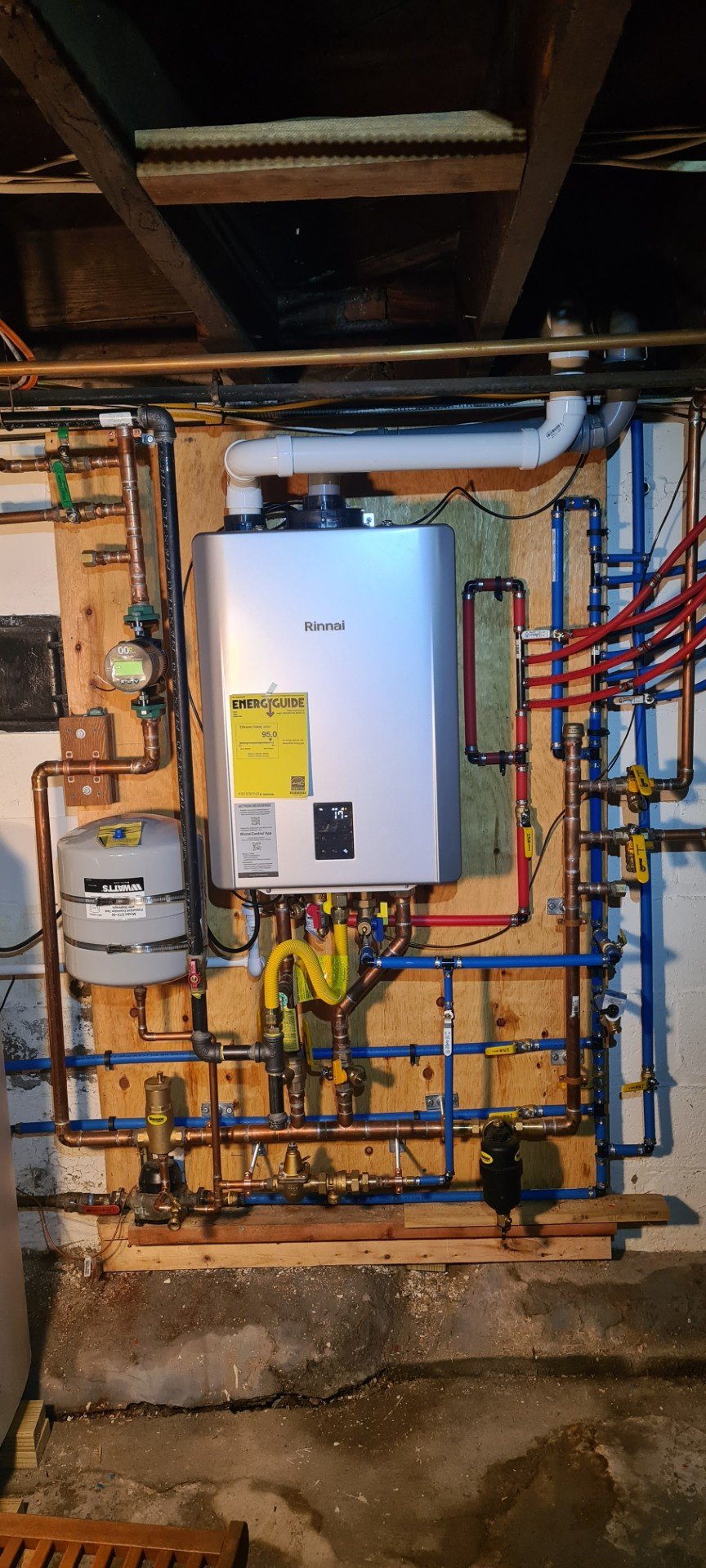Heat loss calc..
Sizing my heat load for a new boiler.. looking at a Rinnai 90k unit
My heat loss using Fuel bill/design days is 36,000btu/hr for my 2000sqft house in NJ..
Manual J using loadcalc.net was about 42,000…
Really? These numbers seems low to me…is this correct…my old failing boiler is like 120k btu.!
Comments
-
-
-
-
-
-
@DIY_Pro, Do you still have the old 120,000 BTU boiler operating? If yes, how long is a burner cycle when the temperature is near zero? (0°F). The reason I ask is that if there is a call for heat for say about an hour and the circulator operates the full hour but the boiler cycles on for 3 minutes and off for 6 minutes, then the entire hour, then your 120K boiler is only using 40,000 BTU in any given hour. That is how you know you are way oversized.
Next thing is that the input of a boiler is how you size the fuel line The NET output is how you size the heat loss. A boiler with a 65,000 BTU input has a 56,000 Output and a 48,000 NET is the correct boiler for you. if you were to put a 42,000 BTU Input boiler, then expect to have problems heating your home when it is below 30°F. That 42,000 input boiler might only have a NET of 31,000 BTU, and that is not enough for your home that requires 42,000.
Edward Young Retired
After you make that expensive repair and you still have the same problem, What will you check next?
1 -
a 50K mod con should give you 43,500 btu per hour at 87%. Higher efficiency if it can run in condensing mode some or all of the time.
The fixed output boiler could drop into the 70% range if it shorts cycles as @EdTheHeaterMan described.
Do you have fin tube baseboard? How many feet of finned tube?
If the home heats comfortably now, then the boiler doesn’t need to be sized any larger than the heaters attached to it.
Bob "hot rod" Rohr
trainer for Caleffi NA
Living the hydronic dream1 -
Ok, the team has spoken! Thank you everyone for your input!
I'm a long time reader of the forum..
@EdTheHeaterMan , yes the old 1970's Burnham America boiler is cycling on/off in short 3 minute-ish cycles as you describe, while the 20yr old Bell&Gossett pump runs a bit longer at maybe 30 min? Your numbers make sense, thanks.
@hot_rod, I currently have 2000sqft + 95' of finned tube over 2 zones (65' 1st floor, 30' 2nd floor). House is comfortable when the heat is running.
I'm planning on combining both zones into a single 95' split zone to get me into condensing temps with a new mod con combi, and avoid a small second floor zone that may cycle.
The Rinnai mod con Combi I'm considering only comes in 60k or 90k for CH, both with199k DHW, both turn down to 15k for CH.
Favoring the 90k unit as I will be adding 1000sqft (+45' finned tube) +1 bath addition next year (a final total of 3000sqft + 135' finned + 2.5bath).
1 -
95 feet of fin tube ELEMENTS (not the shell) can deliver no more than 47,500 BTUH. So any boiler that can deliver MORE than 47,500 BTUH is too large for your house.
If you actually measure the elements (inside the shell) the length will probably be about 85 feet………………resulting in a maximum delivery of 42,500 BTUH. Figure 75% efficiency and the boiler you require is 56,000 BTUH. NOT MORE.
Buy more………pay for more for the entire life of the boiler!!!😫
2 -
I’d highly recommend that you go with a boiler + an indirect water heater. It’s a much more reliable setup with less maintenance and a longer life expectancy.
7” fin tube BB has a heat output of 500 btus per linear foot at 170* AVERAGE water temperature. So, your BBs can produce 42,500 btus - right where the load calc put you. Load calcs typically have about a 10-15% fudge factor built in to cover extreme temperature and high wind. Realistically, you’re not gonna need more than 60k net output even with the proposed addition.
A mod/con Boiler will give priority to an indirect water heater which means that there’s usually no need to upsize the boiler beyond the space heating load to include the domestic. So, 60k btus is your realistic load.
Bob Boan
You can choose to do what you want, but you cannot choose the consequences.4 -
so 135’ of fin tube X 500= 67,5000,
so an 80 or 90,000 btu/ hr mod con covers you nicely. It would modulate down to 8,000 btu/ hr for a zoned system to prevent cycling.
Paired with an indirect you have plenty of capacity for DHW. Go with an 80 gallon if you have a high DHW load, or a large tub to fill.
Consider a mod con that has all the control features to maximize the system efficiency.
Bob "hot rod" Rohr
trainer for Caleffi NA
Living the hydronic dream0 -
So I finally finished the majority of my combi install and I wanted to post an update. DHW has been working well the last month and my gas usage appears half of what is was compared to the same summer month last year. The delay in hot water at the tap seems only a few seconds longer than the with the old gas fired storage tank. Im just finishing the CH piping lines to complete the piping loops with Oxygen barrier pex as it seems much easier to work with compared to the 3/4 copper.
Thank you to everyone who commented in my previous posts. I'll give an update on the fuel savings with the new unit when the cold weather comes.
0 -
-
Thanks for your feedback on my system Ed. I'll take the advice and lower the gas flex. It took me a long time to get it all assembled and working. I have a new appreciation for HVAC/plumbing trades after this project.....
0 -
Very, very nice. That's the straightest PEX installation I've ever seen.
I would have liked a ball valve on the 1/2" line coming out the bottom of the air eliminator so you can isolate both the x-tank and fill valve without draining the system when they need service.
8.33 lbs./gal. x 60 min./hr. x 20°ΔT = 10,000 BTU's/hour
Two btu per sq ft for degree difference for a slab2 -
-
-
Nice! Now insulate those pipes before the cold season starts.
8.33 lbs./gal. x 60 min./hr. x 20°ΔT = 10,000 BTU's/hour
Two btu per sq ft for degree difference for a slab0
Categories
- All Categories
- 87.2K THE MAIN WALL
- 3.2K A-C, Heat Pumps & Refrigeration
- 60 Biomass
- 427 Carbon Monoxide Awareness
- 119 Chimneys & Flues
- 2.1K Domestic Hot Water
- 5.8K Gas Heating
- 115 Geothermal
- 165 Indoor-Air Quality
- 3.7K Oil Heating
- 75 Pipe Deterioration
- 1K Plumbing
- 6.4K Radiant Heating
- 394 Solar
- 15.6K Strictly Steam
- 3.4K Thermostats and Controls
- 56 Water Quality
- 51 Industry Classes
- 49 Job Opportunities
- 18 Recall Announcements








